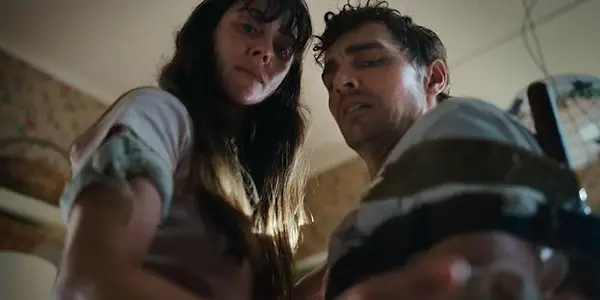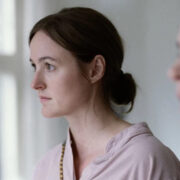In TOGETHER, Comedy is Horror’s Better Half

Payton McCarty-Simas is a freelance writer and artist based in…
Watching Together, first-timer Michael Shanks’ exploration of codependency and millennial malaise, is like finding hair on your toothbrush— it’s grosser when you know where it’s coming from. Starring actual married actors Alison Brie and Dave Franco as a couple who’s been together so long they’ve lost sight of whether it’s love they’re feeling or whether they’re “just used to each other,” this film is so deeply rooted in personal experience that when one partner’s hair does show up stuck between the other partner’s teeth, it feels almost natural. “I don’t want to die and have someone else’s life flash before my eyes,” one says to the other. This clear undercurrent of recognition is the film’s greatest weapon as it mixes sticky body horror with queasy cringe comedy, producing a thin but confident brew best served neat; the water isn’t safe to drink.
Push and Pull
“Everyone thinks it’s cute we’re matching,” Milly (Brie) tells Tim (Franco) at a going away party they’re throwing before they trade city living for what they hope will be arty millennial bliss a few hours away on the commuter line. Tim, a doofy indie rocker type whose dreams of fame have only just begun to dim in earnest at thirty five, is dismayed. He hadn’t noticed. He changes shirts and heads downstairs after Milly, who’s clearly the “responsible one,” having gotten a steady job and seemingly planned the whole move. These opening passages establish the film’s best rhythms— two-steps of miscommunication, petty grievance, and tired, creeping dread— danced by people for whom they’ve sadly become second nature. Milly plans, Tim scrambles; Milly flirts, Tim fumbles; Milly proposes, Tim demurs. One thing we learn right away: The couple hasn’t had sex in a long, long time.

Like in The Amityville Horror, Tim and Milly’s relocation to an elegantly isolated house in the woods brings out their simmering tensions around sex and other issues that may or may not be irreconcilable— though money, notably, isn’t one of them. How they can afford a house with multiple floors’ worth of stained glass on Milly’s elementary school teaching salary alone is entirely unclear, made more distracting when the pair offhandedly discusses “budgeting” after a phone breaks. Nevertheless, the emotional reality the two find themselves muddling through is thick and pungent, like the smell of decay wafting from a rat king Tim finds hidden in the ceiling (certainly a punchier metaphor for letting things fester than the frog in the boiling pot). Soon, the two find themselves trapped in an abandoned hippie temple drinking from a murky pool that may as well have a neon danger sign planted next to it and the situation gets… sticky. Things become lightly Oedipal (mommy issues abound), jealousy rears its ugly head when Milly meets a new colleague (Damon Herriman playfully but effectively flexing his turn as Charlie Manson in Once Upon a Time… in Hollywood), and Tim’s musical ambitions take up more space than Milly would like. But of course, that’s not the premise.
You may be wondering why, in a review of a film about two people fusing together as a metaphor for long-term partnership and its dangers, said fusing hasn’t yet come up. Perhaps because it’s the least interesting thing going on here. As Ari Aster impressions go, Shanks’ isn’t bad. The set pieces (not to mention mise-en-scene and shooting style) borrow more from the likes of Hereditary than The Thing, a film to which Together directly alludes in its cold open. The scares are solid if lightly derivative. Yet as the film progresses, in a reversal of typical genre movie logics, the actual body horror scenes can come to feel more like downbeats than peaks of tension: What’s more stressful, finding your arm supernaturally stuck to your partner’s, or blithely revealing that you feel trapped in a relationship of ten years after one too many glasses of wine? For the most part, the film works best as a simple black tragicomedy (making couples watch Together would make a great challenge on The Ultimatum), and this clear generic preference on the writer-director’s part is only confirmed by the film’s conclusion, whose goofy emotional logics both oddly evoke shades of Celine Song and are likely to spur the heterosexual equivalent of the discourse around the end of Happiest Season. (Meanwhile, no spoilers, but that final shot is a potential font of accidental comedy gold for a queer viewership).
Conclusion
At the end of the day, Together’s most powerful offerings come from its wry reflections on the pleasures and perils of long-term romance. Perhaps counterintuitively, then, this dynamic puts its A24-style body horror takes the back seat to astute cringe comedy somewhere between serious romance and a Tim Robinson bit.
Leonard Cohen put it two ways, “in love we are made, in love we disappear,” and “there is no cure for love. If you have it, it’s a kind of wound. If you don’t have it, it’s worse.” Or, in the immortal words of Pat Benatar, “love is a battlefield.” For veterans of these particular kinds of long-term relationships, Together might prove an oddly rejuvenating experience.
An aside: It’s perhaps ironic that a film dedicated to the perils of ceding one’s identity too much to another would be embroiled in a controversy about plagiarism. But having seen both Together and Better Half— the film whose team filed the lawsuit against Shanks for the films’ similar premises derived from Plato and the use of a rather obviously appropriate Spice Girls song— the similarities between the two are few, far between, and only skin deep, even if skin carries a lot of freight in these particular pictures. I’m reminded of a similar, yet little remembered case of coincidence when an Australian filmmaker sued Universal for plagiarism over I Now Pronounce You Chuck and Larry, a movie whose oh-so-2000-and-late premise (“not-gay firefighters do health insurance fraud and learn to accept queer people along the way”) is so odd and specific, it might come as a shock that the legal team found over 100 points of overlap between its script and that of the plaintiff. Still, it was concluded that the teams had developed their stories completely independently. Sometimes, this stuff just happens— like when a college friend of mine despaired after seeing Parasite because he’d “been working on that story for years.” I resisted asking about the peaches. Apparently, these things are likelier than you’d think! Call it a case of 2 Become 1.
Does content like this matter to you?
Become a Member and support film journalism. Unlock access to all of Film Inquiry`s great articles. Join a community of like-minded readers who are passionate about cinema - get access to our private members Network, give back to independent filmmakers, and more.
Payton McCarty-Simas is a freelance writer and artist based in New York City. They grew up in Massachusetts devouring Stephen King novels, Edgar Allan Poe stories, and Scooby Doo on VHS. Payton holds a masters degree in film and media studies from Columbia University and her work focuses on horror film, psychedelia, and the occult in particular. Their first book, One Step Short of Crazy: National Treasure and the Landscape of American Conspiracy Culture, is due for release in November.













